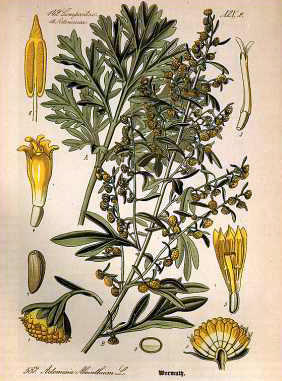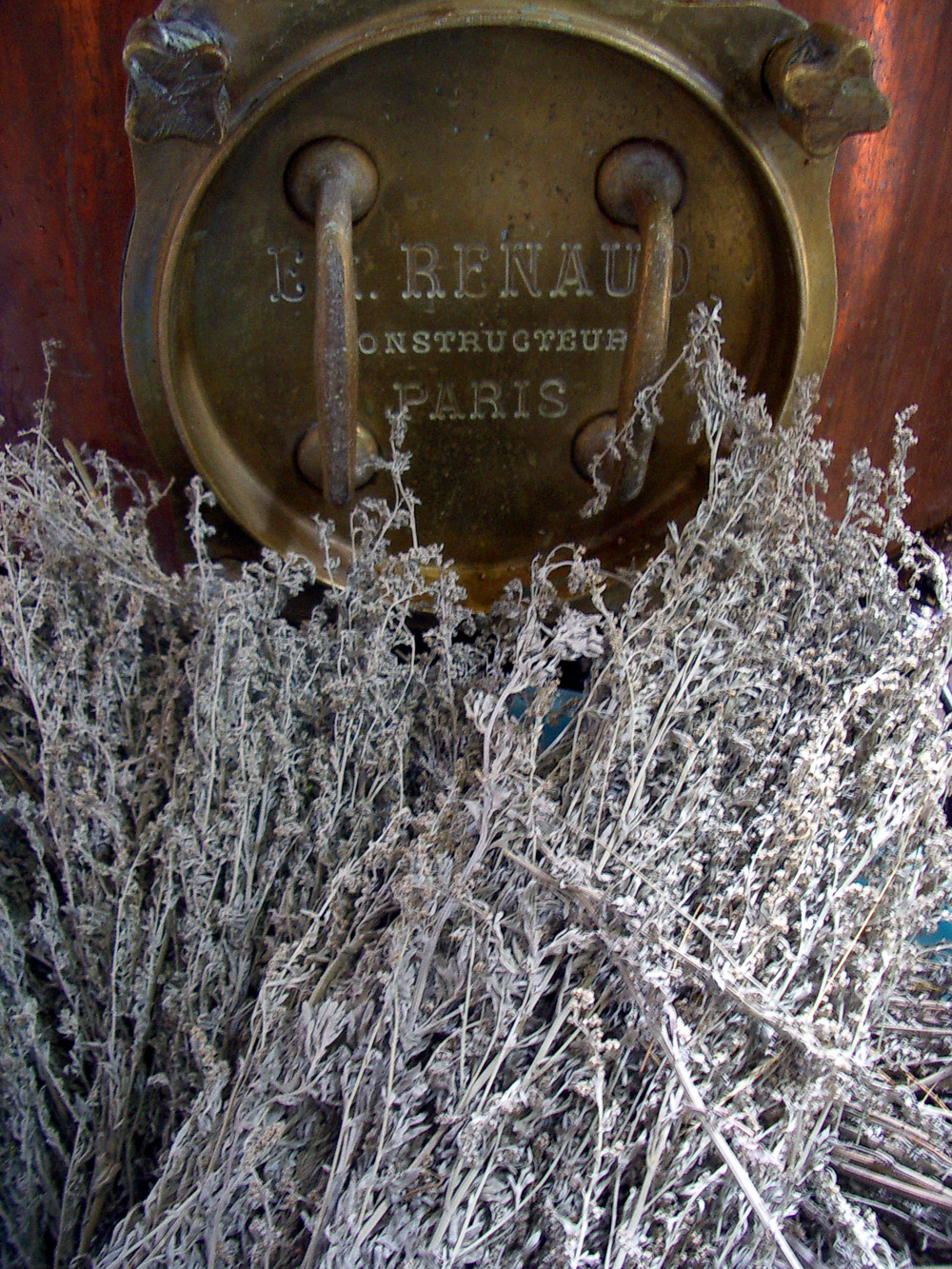Frequently Asked Questions
1) Do your absinthes contain wormwood?
 Absolutely!
Absolutely!
Absinthe derives its name from the plant Artemisia absinthium (aka Grande Absinthe or Grande Wormwood). Real absinthe cannot be created without the use of appropriate quantities of this herb. Like several of our key botanicals, our absinthe is cultivated and harvested to our rigorous historical standards, the quality of which is unequaled in the common commercial market.
More on “wormwood” . . .
Be advised the term “wormwood’ may loosely refer to any of several different plants of the Artemisia genus, and is oftentimes improperly used. In historical literature, “Grand Absinthe” refers specifically to Artemisia absinthium, while “Petite Absinthe” refers specifically to Artemisia pontica (aka Roman Wormwood). Petite absinthe cannot create absinthe on its own, and any claims that petite absinthe refers to something other than Artemisia pontica, and/or that ‘petite absinthe’ creates absinthe are without historical basis, and are used only to fabricate historical authenticity where none exists. Caveat emptor.
2) Where in the U.S. can
your absinthes be purchased?
The efforts of T. A. Breaux and Viridian Spirits (Lucid Absinthe Supérieure) resulted in the 95 year-old U.S. ban on absinthe to be lifted on March 5, 2007. This opened the door for genuine absinthe to be distributed within the U.S. for the first time since 1912. The first Jade absinthe to be released into the U.S. market, Nouvelle-Orléans Absinthe® Supérieure, was introduced into the U.S. at the end of 2008. Due to the limited production volume of the Jade absinthes, the availability of Nouvelle-Orléans Absinthe® Supérieure is limited.
3) Where/how can I buy
your absinthes?
At the present, our absinthes are sold in fine retail shops and on-primise establishments worldwide:
For those in areas where our absinthes may not be distributed, they can be ordered and delivered virtually anywhere in the world via one of our approved online retailers.
4)
Do you ship to Canada?
At the present time, our agents are working to the benefit of Canadian residents.
5) What is the best way to
prepare absinthe?
The most traditional method of preparing absinthe can be viewed in real time here:
www.absintheclassics.com/absinthe_ritual.html
Be advised that the addition of sugar was always optional, and the prevailing experienced opinion is the finest absinthes should be taken without sugar.
Another popular absinthe cocktail was the original Sazerac, explained here:
www.cocktaildb.com/recipe_detail?id=2019
Simply substitute absinthe for pastis. Also note that the original cocktail called for Sazerac brand cognac instead of rye whiskey.
 6)
How long can I store an opened bottle?
6)
How long can I store an opened bottle?
If reasonably well re-sealed with its original cork or a t-cork, a bottle of Jade absinthe can be stored for a century if kept in a dark, cool place (NOT a refrigerator).
7) Why did the color of
the absinthe in an opened bottle change from green to amber?
The traditional, natural color of our absinthes will eventually fade to a feuille mort (dead leaf) tint with time, and a small amount of sediment may form. This is and has always been characteristic of a true absinthe that is crafted from historically correct, natural methods.
8) How much thujone do
your absinthes contain?
The Jade absinthes are absolutely identical in both content and construction to the finest vintage absinthes. The Jade absinthes contain concentrations of thujone and other constituents typical of real, vintage absinthe.
Aside from being absinthe historians and chemists, we possess and have sampled numerous full bottles of the best original absinthes, most of which are over 100 years old. Our analytical research has concluded that the notions promoted about absinthe and thujone are largely modern myths, and were derived from speculation and not actual testing. Contrary to modern assumptions, the original absinthes do not contain high concentrations of thujone, and never did. This fact is actually explained by simple physical chemistry. Our research has been reproduced through recently published scientific studies, a few of which were co-authored by T.A. Breaux, and can be found on the web:
Thujone
Content of Preban Absinthes
Stability
of Thujone in Preban Absinthes
Hutton's
Look at Thujone of Preban Absinthe
Emmert's
Analysis of Modern Absinthes
Emmert's
Analysis of Laboratory Distillations
 Additionally, these
studies prove
something else we already know, which is the claims about thujone
content made by makers/sellers of modern absinthes are almost always
false and misleading, being mostly marketing propaganda.
Additionally, these
studies prove
something else we already know, which is the claims about thujone
content made by makers/sellers of modern absinthes are almost always
false and misleading, being mostly marketing propaganda.
Where thujone is concerned, recent studies such as Dettling, Grass, et al (2004), demonstrate conclusively that human subjects are unable to determine thujone concentrations in test samples by drinking them. In other words, the study proved that whether the thujone concentration of a liquid sample was 0, 10, or 100 mg/kg, human subjects were unable to identify them. Furthermore, thujone has not been demonstrated as a causative agent of any psychotropic or hallucinogenic effects. In short, those who have been led to believe that absinthe delivers effects akin to those afforded by illicit drugs have been misled.
Unfortunately for the average absinthe enthusiast, certain sellers of absinthe (or worse, ‘absinth’) promote erroneous and/or outdated information because they have a poor understanding of the chemistry of absinthe, and/or have reason to deliberately mislead potential consumers into believing absinthe delivers effects akin to that of illicit drugs (which is untrue).
In
light of these facts, we
choose not to publish the thujone content of our absinthes because it
is largely irrelevant except to those who make such claims as a
deceptive marketing tool to boost profits. That being said, if one goes
seeking an absinthe that claims to be ‘high in
thujone’, he will almost invariably find himself purchasing
inferior product that bears little to no
resemblance to traditional absinthe, and whose claims of
‘high thujone’ are almost always false, misleading,
and irrelevant regardless.
For additional reading on the subject, we invite you to browse two research studies T.A. Breaux has co-authored, which are published in a prestigious peer-reviewed scientific journal. These studies provide insight into the content of vintage absinthe and facts about thujone.
9) Do you produce different versions of your absinthes for different countries?
Absolutely not.
10) Do your absinthes
contain sugar?
Traditional absinthes never contained sugar, and neither do ours.
11) Do your absinthes
contain gluten?
Our absinthes employ no grain products and are effectively gluten-free.
12) Are your absinthes
kosher?
While our absinthes do
not come
into contact with any animal products
that violate kosher rules, the eau de vie from which they are distilled
is not prepared by rabbis. Unless or until we find a solution, we
cannot certify them as kosher.